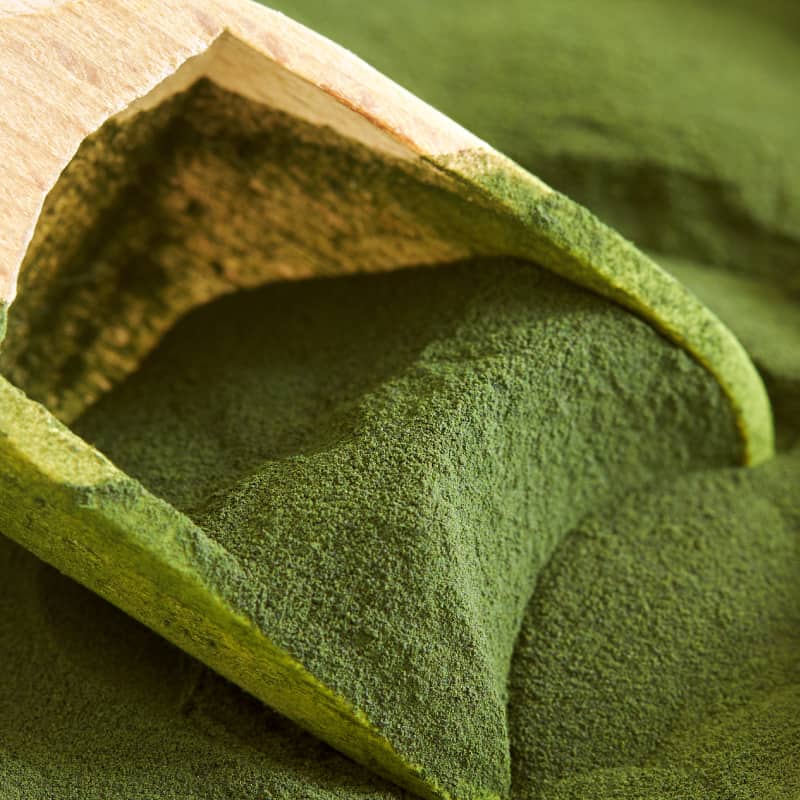This Dr. Axe content is medically reviewed or fact checked to ensure factually accurate information.
With strict editorial sourcing guidelines, we only link to academic research institutions, reputable media sites and, when research is available, medically peer-reviewed studies. Note that the numbers in parentheses (1, 2, etc.) are clickable links to these studies.
The information in our articles is NOT intended to replace a one-on-one relationship with a qualified health care professional and is not intended as medical advice.
This article is based on scientific evidence, written by experts and fact checked by our trained editorial staff. Note that the numbers in parentheses (1, 2, etc.) are clickable links to medically peer-reviewed studies.
Our team includes licensed nutritionists and dietitians, certified health education specialists, as well as certified strength and conditioning specialists, personal trainers and corrective exercise specialists. Our team aims to be not only thorough with its research, but also objective and unbiased.
The information in our articles is NOT intended to replace a one-on-one relationship with a qualified health care professional and is not intended as medical advice.
Green Burial: Is a Natural Burial Right for You? (And Is It Even Legal?)
November 3, 2017
Updated: December 17, 2017
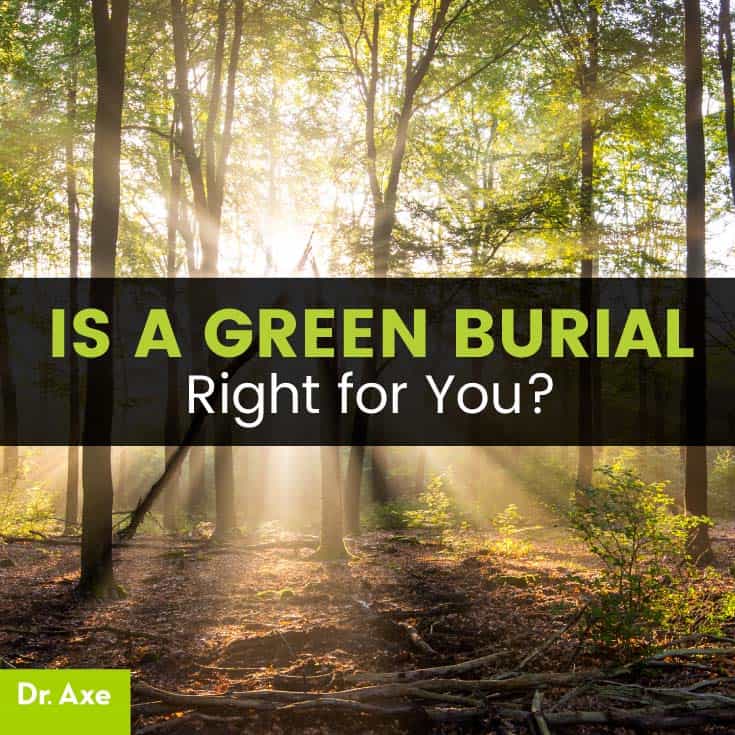
American culture is so sanitized. Think about it … alcohol-based hand disinfectants at every corner of the grocery store, chlorinated water, antibiotics in the food supply, bleached laundry and kitchen floors. No wonder we are so sick! But this hyper-sanitized state doesn’t end there. It’s even infiltrating down to death. Today, modern care for the dead generally involves whisking the body away for a formaldehyde-based embalming and high-impact burial.
While the Civil War was a major turning point that triggered widespread embalming, the truth is we were already headed in that direction around the turn of the 19th Century, thanks to “sanitation” reforms sweeping the globe. Suzanne Kelly, author of “Greening Death,” says this time period marks the beginning of the “war on filth,” corpse style.
Deadly outbreaks of measles, yellow fever and cholera were largely misunderstood at the time, and people thought “miasmatic vapors,” the foul smell spewing in from garbage and human corpses, spread disease. (This was before we knew microorganisms, not smells, were the actual culprits.)
But fear of the decomposing corpse reached a fever pitch, and cities and towns passed laws banning human burials within their borders. This marked the beginning of sanitizing death.
And the beginning of a funeral industry that today rakes in $16 billion annually in the U.S. alone. (1)
But we’re starting to see a backlash to these modern-day burial methods as the idea of green burial is gaining momentum in the United States once again.
What Is a Green Burial?
What is a green burial service? Also known as “natural burial,” the Green Burial Council describes a green burial as something that: (2)
- Impacts the environment minimally while caring for the dead
- Conserves natural resources
- Limits carbon emissions
- Protects workers’ health
- Promotes the restoration or preservation of habitat
In other words, it’s returning the body back to the earth in its natural form, where it will ultimately feed microbes in the soil and benefit other forms of life. While this more traditional burial may seem “creepy” to some today, natural burial was common for generations before the Civil War.
Hallmark features of today’s green burials include using:
- No toxic chemicals, including embalming fluid
- Biodegradable caskets
- Biodegradable shrouds or urns
- Minimizing the use of fossil fuels for burial
Not all green burial sites are created equally. The Green Burial Council identifies three levels of green burial grounds. As you can see, some are more conservation-minded than others, so do your homework and make sure a potential site matches your wants and needs. (For instance, some are certified to remain a preserve in perpetuity, while others aren’t.)
- Hybrid. These burial sites are generally conventional cemeteries that offer a “green” section, allowing for the burial of umembalmed bodies in biodegradable caskets or shrouds. The cemetery may still allow the use of pesticides, turf lawn and non-native plants.
- Natural burial grounds. Only unembalmed bodies are buried at these sites. Toxic chemicals, cement and metal vaults, traditional marble/stone grave markets and caskets made of non-biodegradable materials are banned. These burial sites also implement waste-reducing and energy-conserving guidelines to improve sustainability.
- Conservation burial sites. This is the gold standard green burial if you’re looking to support land conservation. These burial grounds require an independent conservation group, like a land trust, to oversee the land. This ensures it will remain as a conservation easement or land permanently preserved in its natural state. (3)
There are also funeral homes that offer or specialize in home funerals and green burials.
Brief History of Embalming
But first, how did we get to this place? How did embalming become the norm? Before the 19th Century, pretty much everyone had a green burial. And while embalming may be common practice now, it really came of age during the Civil War, due to an outcry for fallen soldiers to return home to their families intact for viewing and burial. And get this: Arsenic used in those early embalming procedures is still being detected in soil and water near burial sites of Civil War soldiers. (Not everyone bought into embalming … Jewish and Muslim burial traditions have banned embalming for thousands of years.) (4, 5)
By the 1930s, the practice of embalming, along with using ornate caskets made of metal and precious hardwoods, became a mainstay of American deathcare, as Jessica Mitford explained in her landmark book, The American Way of Death, published in 1963. She charged that the whole new way of dealing with death, including displaying the body in a funeral home and burying it in concrete or steel vault in the grave, was invented by the American funeral industry. (6)
The good news is, with careful planning, you don’t have to have that type of funeral or burial if you don’t want to. (And by the way, if you have buried someone this way, please do not feel remorse. Our current system is set up to support an embalming-based burial. But please just know that if you’d like something different, it is within reach.)
Is it legal to have a natural burial?
- Yes, but not all cemeteries offer this option.
- Kinkaraco, a green funeral products company, keeps a state-by-state list of green cemeteries that do not require embalming, a grave liner or vault.
- Or course, lobbying your local cemetery to open a green section for natural burials is also an option to bring green services to your community.
- Check your state and local laws to see if you can create an area of your property to be zoned as a “home cemetery.” The rules and requirements may differ depending on how many people you may want to bury on your family’s land … and the acreage of your plot of land. And you will likely need to register coordinates of buried bodies with local officials. (7)
- If you plan a burial on your private property, be sure to check state and local laws regarding who may fill out a death certificate and file it with the local registrar.
- If opting for a home funeral, you can choose to work with a home funeral-friendly funeral home to help prepare the body or you and family members can prepare the body with gentle soap and essential oils. Look for a home funeral guide from your state to help direct you through the legalities and options available.
Are coffins biodegradable?
- If you’re opting for a green burial, you’ll want to bypass coffin options offered in most conventional funeral homes.
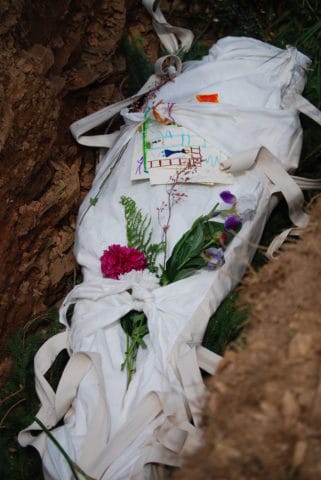 Natural burials commonly use a natural fiber bed sheet, biodegradable shroud, a pine, seagrass or wicker box, natural papier-mâché or even a cardboard box. The general idea is that it’s natural, untreated wood or organic fiber. That way, it’ll break down and enhance the soil, not harm it.
Natural burials commonly use a natural fiber bed sheet, biodegradable shroud, a pine, seagrass or wicker box, natural papier-mâché or even a cardboard box. The general idea is that it’s natural, untreated wood or organic fiber. That way, it’ll break down and enhance the soil, not harm it.- You’ll want to avoid any stains, varnishes, paints or other finishes because they likely contain harmful chemicals. Stick to untreated.
- Many green burial sites also allow loved ones to bury cremated remains.
- Ashes after a cremation are inorganic bone fragments. You can grow a tree over the ashes, but they aren’t actually feeding the tree or soil.
How does a burial work?
- Whether the green burial is on private property approved for a burial or in a green cemetery, certain characteristics remain the same.
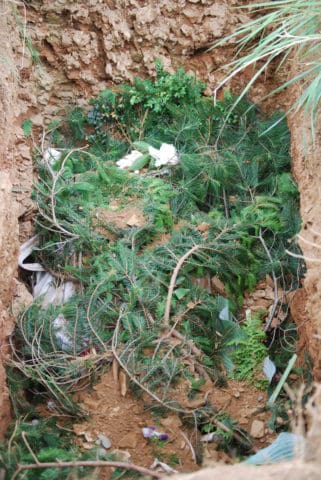
- Grave depth: About 3.5 feet deep. This is ideal for rapid aerobic decomposition; the depth also prevents attracting animals during the decomposition process.)
- Instead of fake green turf, wooden boards typically surround the grave opening to prevent soil collapse.
- Local greenery and wildflowers often cover excavated soil and may line the bottom of the grave.
- Clergy service, military honors, music and readings may be part of a green burial.
- For lowering, slats are usually placed under the body and across the grave, with ropes or straps under the shroud or coffin for lowering when the slats are removed. Human power is often used to lower the body into the grave. And some shrouds are even constructed with built-in lowering straps.
- Loved ones often help cover the body with soil. Once covering is complete, it may take several weeks for the soil to settle. Over time, if left alone, nature will reclaim the grave in the meadow or forest. (8)
- Natural burial sites often include wildflowers, trees and shrubs that are native to that particular area.
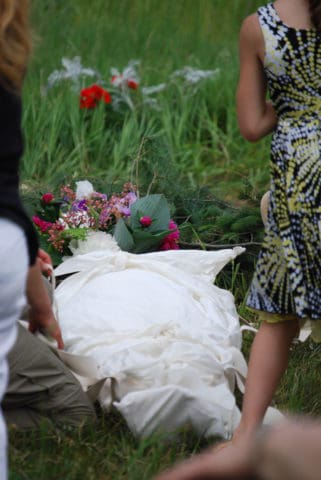
Can a body be buried without being embalmed?Yes. Yes. Yes. Let’s scream this from the rooftops, since most people think embalming is legally required. The truth is it’s only required in rare cases.
- There are just a handful of states that require embalming. Embalming is required for a body crossing state lines from Alaska and Alabama. California, Idaho, Kansas, Minnesota and New Jersey only require embalming if the body is transported across state lines by airplane or train.
- The Federal Trade Commission mandates that funeral directors inform consumers that embalming is not legally required except in certain special cases, according to the Funeral Consumers Alliance.
- Some states require embalming or other preservation methods if a certain amount of time lapses between death and burial. (There are often other options, like refrigeration or dry ice, that also work in this case.)
- Check with your state health department or invest in the book Final Rights for a primer in home funerals and DIY green burial. (9)
Home funerals and other important considerations
- Depending on your state laws, you may need to use some sort of preservation method if more than 24 hours passes before a dead body is buried. For instance, in Idaho, a body must be embalmed or refrigerated if it won’t be buried within 24 hours after death. (Some funerals homes will offer refrigeration-only services.)
- Other states don’t lay out a specific timeline, but many families who opt for a home funeral before a green burial keep a room as cold as possible with one or multiple air conditioners, dry ice or frozen gel packs.
- Even if your loved one dies in a hospital or other facility, you have the right to transport them, unembalmed, to your home or funeral home of choice. (There are some rare restrictions if you’re crossing certain state lines or if the person suffered from a highly contagious, deadly disease.)
Benefits of a Green Burial
Formaldehyde-free burial. Arsenic was the cocktail of choice for embalming up into the early 1900s. But formaldehyde eventually made its way into funeral homes across the country and remains a go-to ingredient in embalming fluid today. As Kelly points out in Greening Death, the funeral industry uses 4.3 million gallons of embalming fluid a year; besides carcinogenic formaldehyde, 42 other federally regulated substances can be found in embalming fluid.
“But what’s perhaps the most alarming about the way embalming has developed over the last 150 years is that by dosing the body with toxic chemicals the dead have become poisoned. In its quest to eradicate filth and safeguard the living, the use of embalming has effectively succeeded in turning the dead into something dangerous, a real pollutant.” — Suzanne Kelly, author of Greening Death
When we bury people in the U.S., we collectively add about eight Olympic-sized swimming pools worth of of embalming fluid to the soil every year. (10) Maybe that wouldn’t be a huge deal, except the National Toxicology Program lists formaldehyde, the main embalming ingredient, as “known to be a human carcinogen.” The International Agency for Research on Cancer (IARC) identifies formaldehyde as “carcinogenic to humans” due to its link to nasopharyngeal cancer and leukemia. Even the Environmental Protection Agency (EPA) admits formaldehyde is a “probably human carcinogen.” And National Cancer Institute data suggests formaldehyde is linked particularly to myeloid leukemia in humans. (11)

And let’s not forget the impact formaldehyde-laced embalming fluid is having on workers, too. Multiple studies linked formaldehyde exposure to debilitating and possibly fatal health risks such as:
- ALS (12)
- Cancer
- Damaged pulmonary function (13)
- Allergic dermatitis
- Depression (14)
The appeal of a formaldehyde-free burial is getting out. A 2007 AARP survey found that nearly 25 percent of respondents agreed they would opt for green burial if the U.S. banned formaldehyde embalming. (15)
Works with nature, not against it. Just like our guts, soil also contains a diverse ecological microbiome. (16) An interplay of the bacteria living within us, microorganisms in the soil and body-feasting insects help recycle a body back into the earth. But get this: Embalming actually hinders that process, repelling beneficial beetles and flies that help break down human bodies, Kelly points out in Greening Death.
And while some people may worry that green burial threatens drinking water supplies, the Green Burial Council notes that burying human bodies at a depth of 3.5 feet and adhering to mandatory setbacks from known water sources protests potable water found 75 feet below the surface. (17)
Burial minus the metal. Here’s another reasons green burials are increasing in popularity … they use less resources. Did you know we bury enough metal each year to build another Golden Gate Bridge? Instead of energy-intensive metal caskets and vaults, natural burials focus on using low-impact biodegradable shrouds, pine or wicker caskets that actually feed microorganisms in the soil, not repel them. You can even find basic green burial caskets on Etsy these days … and some people even opt to build their own. (Just use sustainable wood, not plywood and glues.)
Concrete-free burials. It’s true that burning coal, oil and natural gas are potent creators of mercury pollution that can ultimate lead to mercury poisoning. But did you know the making of cement, one of the main ingredients in concrete, is a huge industrial mercury emitter, too?
If you took all of the reinforced concrete laid into the ground for modern-day burial vaults annually, you could build a two-lane highway from Detroit to New York.
More affordable. Green burials may cost several hundred to $2,000 dollars, on par or a bit more expensive than a cremation, but much less than the average modern funeral costs, which averages about $8,000. (18)
Land conservation. Increasingly, natural burial is a tool used to promote land conservation. By purchasing a conservation grave plot for an unmarked, green burial, you can help preserve woods and fields otherwise threatened by development. Conservation burial grounds promote the planting and protection of native tree and plants to help better support biodiversity in that area. Ramsey Creek Preserve in South Carolina is known as America’s first conservation burial ground. (19)
Here are closer looks at green burial conservation cemeteries in Florida and New Jersey:
How to Have a Natural Burial
The good news? Your options for natural, green burials are growing once again. Green burials gained national attention in 2005, when the HBO series Six Feet Under culminated with a natural burial. And the simultaneous shift toward less toxic living is opening people’s eyes to the impact they have on the planet not just during life, but in death, too.
- How much is a natural burial? If you’re wondering how much does it cost for a green burial, know that it varies widely based on a number of factors. But in general, you can pull off a natural burial for way less than a standard funeral most common today. A typical embalming-based American funeral today costs about $6,500, plus up to $2,000 for a burial plot. A green burial may be much cheaper, with plots ranging from a few hundred dollars to about $2,000. If you’re doing it on your own land, costs are minimal and related only to zoning changes you may need to make, along with the cost of a shroud or biodegradable burial box. (20)
- What states offer green burials? Pre-planning is your best friend if a natural burial is on your afterlife wish list. That’s because green burial laws vary depending on where you live. The first step is to check burial laws by state. From there, you’ll need to drill down and check your local zoning laws, particularly if you want to investigate turning part of our own property into a legal “cemetery” for your burial or the burial of family members. Municipalities often have laws that restrict burial close to waterways, require minimum acreage and so on.
Other Alternatives to Conventional Burial
Cremation
- In 2016, 50.2 percent of Americans chose traditional cremation, up from 48.5 percent in 2015. More affordable than modern burials, flame-based cremation costs about $4,200. (21)
- Flamed-based cremation isn’t necessarily eco-friendly.
- Some estimates suggest that the amount of energy used in one fire-based cremation could heat a Minnesota home for an entire winter. (22)
- Uses natural gas and propane, including gas from harmful fracking operations, to power cremation.
- Releases mercury into the air. The EPA estimates crematoriums release 320 pounds of mercury into the air annually, other opponents say this number could be as high as three tons. (23)
Donating Body to Science
- Could help further science searching for cures for diseases.
- Beware, however, of a 2017 special Reuters investigation found:
- Bodies donated to science are often sold in unregulated body part markets.
- Some bodies are dismembered using chainsaws or similar coarse cutting devices.
- This body broker business is largely unregulated in the U.S.
- Body brokers often team up with funeral homes for lucrative partnerships. Funeral directors can refer poor people to body donation because cremation after dissection is free. (24)
- Still want to donate your body to science? Consider working directly with a specific university, as long as you understand and agree to their terms. You may want to look into “Body Farms” at five U.S. universities, where taphonomists study decomposition of composting bodies. These scientists study how the human body breaks down in different conditions. This information is sometimes used in forensics to help solve crimes. (25)
Alkaline Hydrolysis, AKA ‘Water Cremation‘
- Also known as aquamation or bio-cremation.
- By 2017, 15 U.S. states legalized the process.
- Involves using a potassium hydroxide-based alkaline solution to essentially liquefy a body, leaving a skeleton that is crushed into ashes
- Some call it a “tissue digester,” and the liquid remains are treated in the municipal water supply. (26, 27)
- Releases no mercury vapors into the air like flame cremation.
- Creates four times less carbon impact compared to flame cremation.
- Medical implants do not need to be removed, are unaffected by the process and can possibly be recycled. (28)
Options for Your Ashes
Depending on how creative you’d like to get, you can ask loved ones to turn your ashes into other things, although all of these aren’t considered green except the reef ball and eco burial tree.
- Eco burial tree or living urn (29)
- Reef ball to support ocean life
- Paperweight
- Space flight
- Diamond
- Vinyl record (30)
Green Burial Resources
While I do know of people who pulled off a green burial with only a few weeks notice, rushing the planning only adds stress. Although it likely involves a little legwork on your end, it is possible to have a green burial. Here are some resources to help you get started.
Online
Books
- Final Rights: Reclaiming the American Way of Death by Joshua Slocum and Lisa Carlson
- Greening Death by Suzanne Kelly
- Grave Matters: A Journey Through the Modern Funeral Industry to a Natural Way of Burial by Mark Harris
Planning Books/PDF
- Before I Go You Should Know
- Record detailed funeral plans
- Provide info to help loved ones wind down your affairs
- Green Burial Council Funeral Planning Guide
Final Thoughts on the Green Burial Option
- Before the 19th Century, virtually everyone had a “green burial.”
- At the turn of the 19th Century, society feared that smells related to rotting corpses could be a main cause of disease transmission.
- We now know germs, not smells, transmit many diseases. But sanitation reform of the early 19th Century laid the roots of fear and over-sanitation that led to the modern funeral industry.
- The Civil War made embalming with harsh chemicals more common because families wanted fallen solders to be transferred home intact.
- Since then, modern-day funerals typically consist of embalming, exotic hardwood or metal caskets, reinforced concrete vaults and burial in manicured cemeteries.
- Modern-day burial practices don’t support the body’s natural decomposition.
- Even if your loved one dies in a hospital or other facility, you have the right to transport them, unembalmed, to your home or funeral home of choice. (There are some rare restrictions if you’re crossing certain state lines or if the person suffered from a highly contagious, deadly disease.)
- There are many options for green burial, also known as natural burial, in both cemeteries and private properties.
- It’s important to pre-plan if you’d like a green burial. An understanding of state and local zoning laws is required for a smooth planning process.
- Green burials use biodegradable shrouds or coffins, focus on using minimal fossil fuels and may even preserve land.
- To find a “green burial near me,” use Green Burial Council resources.
Read Next: Climate Change and Nutrition: ‘Junk Food Effect’ Is Making Crops Nutrient Deficient





